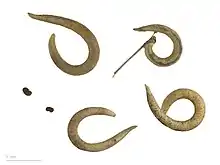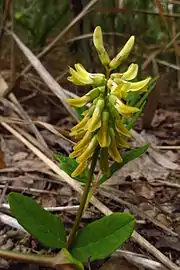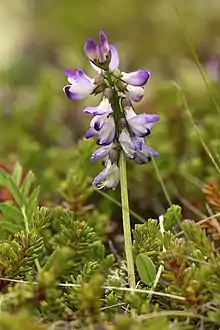| Astragalus | |
|---|---|
 | |
| A. lentiginosus | |
| Scientific classification | |
| Kingdom: | Plantae |
| Clade: | Tracheophytes |
| Clade: | Angiosperms |
| Clade: | Eudicots |
| Clade: | Rosids |
| Order: | Fabales |
| Family: | Fabaceae |
| Subfamily: | Faboideae |
| Tribe: | Galegeae |
| Subtribe: | Astragalinae |
| Genus: | Astragalus L. |
| Type species | |
| Astragalus onobrychis L. | |
| Species | |
|
Over 3,000 species, see list of Astragalus species | |
| Synonyms[1] | |
| |

Astragalus is a large genus of over 3,000 species[2] of herbs and small shrubs, belonging to the legume family Fabaceae and the subfamily Faboideae. It is the largest genus of plants in terms of described species.[3] The genus is native to temperate regions of the Northern Hemisphere. Common names include milkvetch (most species), locoweed (in North America, some species)[4] and goat's-thorn (A. gummifer, A. tragacantha). Some pale-flowered vetches (Vicia spp.) are similar in appearance, but they are more vine-like than Astragalus.
Description
Most species in the genus have pinnately compound leaves.[5] There are annual and perennial species. The flowers are formed in clusters in a raceme, each flower typical of the legume family, with three types of petals: banner, wings, and keel. The calyx is tubular or bell-shaped.[6][7]
Taxonomy
The genus was formally described in 1753 by Carl Linnaeus in his Species Plantarum.[8]
The name Astragalus is Greek, an old name for this group of plants which were believed to have a positive effect on goat milk production.[9]
Selected species
- Astragalus acutirostris – sharpkeel milkvetch
- Astragalus agnicidus – Humboldt County milkvetch
- Astragalus agrestis – field milkvetch, purple milkvetch, cock's-head
- Astragalus albens – Cushenbury milkvetch
- Astragalus alpinus – alpine milkvetch, mountain locoweed
- Astragalus amphioxys – crescent milkvetch
- Astragalus ampullarioides – Shivwits milkvetch
- Astragalus andersonii – Anderson's milkvetch
- Astragalus anemophilus – San Quintin Dune milkvetch
- Astragalus anisus
- Astragalus annularis
- Astragalus anserinus – Goose Creek milkvetch
- Astragalus anxius – troubled milkvetch
- Astragalus applegatei – Applegate's milkvetch
- Astragalus arrectus – Palouse milkvetch
- Astragalus asymmetricus – San Joaquin milkvetch
- Astragalus atropilosulus
- Astragalus austiniae – Austin's milkvetch
- Astragalus australis – Indian milkvetch
- Astragalus azizi – Iranian milkvetch
- Astragalus barrii – Barr's milkvetch
- Astragalus bernardinus – San Bernardino milkvetch
- Astragalus bibullatus – limestone-glade milkvetch
- Astragalus bicristatus – crested milkvetch, two-crested milkvetch
- Astragalus bidentatus
- Astragalus bisulcatus – two-groove milkvetch
- Astragalus boeticus – kaffevedel (Swedish)[10]
- Astragalus alopecurus
- Astragalus bolanderi – Bolander's milkvetch
- Astragalus brachycalyx
- Astragalus brauntonii – Braunton's milkvetch
- Astragalus breweri – Brewer's milkvetch
- Astragalus californicus – California milkvetch
- Astragalus canadensis – Canadian milkvetch
- Astragalus casei – Case's milkvetch
- Astragalus cavanillesii
- Astragalus cicer – wild lentil, chickpea milkvetch
- Astragalus cimae – Cima milkvetch
- Astragalus claranus – Clara Hunt's milkvetch, Napa milkvetch
- Astragalus clevelandii – Cleveland's milkvetch
- Astragalus coccineus – scarlet milkvetch, scarlet locoweed
- Astragalus congdonii – Congdon's milkvetch
- Astragalus cremnophylax – Sentry milkvetch
- Astragalus crotalariae – Salton milkvetch
- Astragalus curtipes – Morro milkvetch
- Astragalus danicus – purple milkvetch
- Astragalus deanei – Deane's milkvetch, Dean's milkvetch
- Astragalus desereticus – Deseret milkvetch
- Astragalus didymocarpus – two-seeded milkvetch, dwarf white milkvetch, white dwarf locoweed
- Astragalus distortus – Ozark milkvetch
- Astragalus douglasii – Douglas's milkvetch
- Astragalus ehrenbergii
- Astragalus ertterae – Walker Pass milkvetch
- Astragalus falcatus
- Astragalus filipes – basalt milkvetch
- Astragalus funereus – Funeral Mountain milkvetch
- Astragalus gambelianus – Gambel's dwarf milkvetch, dwarf locoweed
- Astragalus gibbsii – Gibbs's milkvetch
- Astragalus gilmanii – Gilman's milkvetch
- Astragalus glycyphyllos – wild liquorice, licorice milkvetch
- Astragalus harbisonii - Punta Baja milkvetch
- Astragalus holmgreniorum – Holmgren locoweed
- Astragalus humillimus – Mancos milkvetch
- Astragalus hypoxylus – Huachuca Mountain milkvetch
- Astragalus inversus – Susanville milkvetch
- Astragalus inyoensis – Inyo milkvetch
- Astragalus iselyi – Isely's milkvetch
- Astragalus jaegerianus – Lane Mountain milkvetch
- Astragalus johannis-howellii – Long Valley milkvetch
- Astragalus kentrophyta – spiny milkvetch
- Astragalus layneae – widow's milkvetch
- Astragalus lemmonii – Lemmon's milkvetch
- Astragalus lentiformis – lens pod milkvetch
- Astragalus lentiginosus – freckled milkvetch, mottled locoweed, speckled locoweed, spotted locoweed
- Astragalus lentiginosus var. iodanthus – Humboldt River milkvetch
- Astragalus lentiginosus var. pseudiodanthus – Tonopah milkvetch
- Astragalus leontinus – Tyrolean milkvetch
- Astragalus leptaleus
- Astragalus leucolobus – Bear Valley woollypod, Bear Valley milkvetch
- Astragalus limnocharis
- Astragalus limnocharis var. montii – Monti's milkvetch
- Astragalus linifolius – Grand Junction milkvetch
- Astragalus loanus – Glenwood milkvetch
- Astragalus lotoides
- Astragalus malacus – shaggy milkvetch
- Astragalus microcymbus – Skiff milkvetch
- Astragalus miguelensis – San Miguel milkvetch
- Astragalus missouriensis – Missouri milkvetch
- Astragalus mohavensis – Mojave milkvetch
- Astragalus molybdenus
- Astragalus mongholicus – huang qi (黄芪/黃芪 huáng qí; běi qí 北芪) Mongolian milkvetch
- Astragalus monoensis – Mono milkvetch
- Astragalus monspessulanus
- Astragalus mulfordiae – Mulford's milkvetch
- Astragalus nevinii – San Clemente Island milkvetch
- Astragalus newberryi – Newberry's milkvetch
- Astragalus nitidiflorus – Tallante's milkvetch
- Astragalus nutans – Providence Mountains milkvetch
- Astragalus nuttallianus – small-flowered milkvetch
- Astragalus nuttallii – Nuttall's milkvetch
- Astragalus obscurus – arcane milkvetch
- Astragalus onobrychis
- Astragalus oocarpus – Descanso milkvetch, San Diego milkvetch
- Astragalus oophorus – egg milkvetch
- Astragalus osterhoutii – Osterhout milkvetch
- Astragalus oxyphysus – Mt. Diablo milkvetch, Diablo locoweed
- Astragalus pachypus – thickpod milkvetch
- Astragalus panamintensis – panamint milkvetch
- Astragalus pauperculus – depauperate milkvetch
- Astragalus phoenix – Ash Meadows milkvetch
- Astragalus platytropis – broadkeel milkvetch
- Astragalus pomonensis – Pomona milkvetch, Pomona locoweed
- Astragalus proimanthus – precocious milkvetch
- Astragalus proximus
- Astragalus pulsiferae – Ames's milkvetch
- Astragalus purshii – Pursh's milkvetch, Woollypod milkvetch, woollypod locoweed
- Astragalus pycnostachyus – Marsh milkvetch
- Astragalus rattanii – Rattan's milkvetch
- Astragalus ripleyi
- Astragalus robbinsii – Robbins's milkvetch
- Astragalus sabulonum – gravel milkvetch
- Astragalus sarcocolla
- Astragalus scaphoides – bitterroot milkvetch
- Astragalus schmolliae – Schmoll milkvetch
- Astragalus shevockii – Shevock's milkvetch, Little Kern milkvetch
- Astragalus sinicus – Chinese milkvetch, renge
- Astragalus sinuatus – Whited's milkvetch
- Astragalus soxmaniorum – Soxman's milkvetch
- Astragalus subvestitus – Kern County milkvetch
- Astragalus tener – alkali milkvetch
- Astragalus tennesseensis – Tennessee milkvetch
- Astragalus tidestromii – Tidestrøm's milkvetch
- Astragalus tragacantha
- Astragalus traskiae – Trask's milkvetch
- Astragalus tricarinatus – triple-ribbed milkvetch
- Astragalus trichopodus – Santa Barbara milkvetch, coast locoweed, Southern California locoweed
- Astragalus tuyehensis from Iran
- Astragalus tyghensis
- Astragalus umbraticus – Bald Mountain milkvetch
- Astragalus webberi – Webber's milkvetch
- Astragalus wetherillii
- Astragalus whitneyi – balloon-pod milkvetch
- Astragalus zionis – Zion milkvetch
_2.jpg.webp) Astragalus testiculatus
Astragalus testiculatus

 Astragalus dasyanthus
Astragalus dasyanthus
Ecology
Astragalus species are used as food plants by the larvae of some Lepidoptera species including many case-bearing moths of the genus Coleophora: C. cartilaginella, C. colutella, C. euryaula, and C. onobrychiella feed exclusively on Astragalus, C. astragalella and C. gallipennella feed exclusively on the species Astragalus glycyphyllos, and C. hippodromica is limited to Astragalus gombo.
Uses
Traditional medicine
Astragalus has been used in traditional Chinese medicine over centuries to treat various disorders, but there is no high-quality evidence that it is effective or safe for any medical purpose.[11][12]
Phytochemicals and supplements
Extracts of astragalus root include diverse phytochemicals, such as saponins and isoflavone flavonoids, which are purported in traditional practices to increase lactation in nursing mothers.[13] There is no valid clinical evidence to indicate such use is effective or safe for the mother or infant.[13] Dietary supplement products containing astragalus extracts may not have been adequately tested for efficacy, safety, purity or consistency.[13] The root extracts of astragalus may be used in soups, teas or sold in capsules.[11]
Side effects and toxicology
Although astragalus supplements are generally well tolerated, mild gastrointestinal upset, diarrhea, and allergic reactions may occur.[11][13] Because astragalus may affect regulation of blood sugar and blood pressure, it may be risky for people with blood disorders, diabetes, or hypertension to use it as a supplement.[11] Astragalus may interact with prescribed drugs that suppress the immune system, such as medications used by people being treated for cancer or recovery from organ transplants.[11]
Some astragalus species can be toxic, such as those found in the United States containing the neurotoxin swainsonine, which causes "locoweed" poisoning in animals.[11] Some astragalus species may contain high levels of selenium, possibly causing toxicity.[11]
Ornamental use
Several species, including A. alpinus (bluish-purple flowers), A. hypoglottis (purple flowers), and A. lotoides, are grown as ornamental plants in gardens.
Notes
References
- ↑ "Astragalus L." Plants of the World Online. Board of Trustees of the Royal Botanic Gardens, Kew. 2017. Retrieved 6 July 2020.
- ↑ "Astragalus L." Plants of the World Online. Royal Botanical Gardens Kew. Retrieved 6 January 2019.
- ↑ Frodin, David G. (2004). "History and Concepts of Big Plant Genera". Taxon. 53 (3): 753–76. doi:10.2307/4135449. JSTOR 4135449.
- ↑ "Astragalus (Locoweed) flowers". Rootcellar.us. Archived from the original on 2013-11-13. Retrieved 2013-07-05.
- ↑ Taylor, Ronald J. (1994) [1992]. Sagebrush Country: A Wildflower Sanctuary (rev. ed.). Missoula, MT: Mountain Press Pub. Co. p. 100. ISBN 0878422803. OCLC 25708726.
- ↑ Xu, Langran; Podlech, Dietrich. "Astragalus". Flora of China. Vol. 10. Retrieved 9 December 2018 – via eFloras.org, Missouri Botanical Garden, St. Louis, MO & Harvard University Herbaria, Cambridge, MA.
- ↑ "A Guide to the Common Locoweeds and Milkvetches of New Mexico". aces.nmsu.edu. New Mexico State University. Retrieved 9 December 2018.
- ↑ "Astragalus L." ipni.org. International Plant Names Index. Retrieved 10 December 2018.
- ↑ Wilhelm, Gerould; Rericha, Laura (2017). Flora of the Chicago Region: A Floristic and Ecological Synthesis. Indiana Academy of Sciences.
- ↑ "Astragalus boeticus L." USDA - Agricultural Research Service National Plant Germplasm System GRIN-Taxonomy. Beltsville, Maryland. 2018. Archived from the original on 17 September 2018. Retrieved 17 September 2018.
- 1 2 3 4 5 6 7 "Astragalus". National Center for Complementary and Integrative Health, US National Institutes of Health. 29 November 2016. Retrieved 1 July 2019.
- ↑ Su, Guobin; Chen, Xiankun; Liu, Zhuangzhu; Yang, Lihong; Zhang, La; Stålsby Lundborg, Cecilia; Wen, Zehuai; Guo, Xinfeng; Qin, Xindong; Liang, Jueyao; Liu, Xusheng (1 December 2016). "Oral (Huang qi) for preventing frequent episodes of acute respiratory tract infection in children". Cochrane Database of Systematic Reviews. 2016 (12): CD011958. doi:10.1002/14651858.CD011958.pub2. PMC 6463872. PMID 27905672.
- 1 2 3 4 "Astragalus". Drugs and Lactation Database (LactMed), National Library of Medicine, US National Institutes of Health. 3 December 2018. PMID 30000951.
External links
- Astragalus – Genus of vascular plants
- Astragalus – Clinical summary and constituents, MSKCC Memorial Sloan Kettering Cancer Center